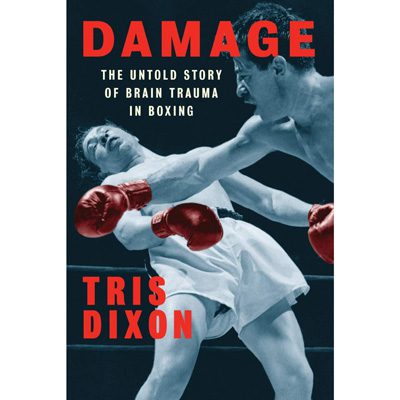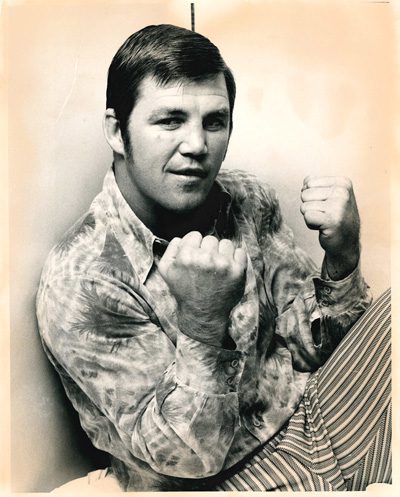Damage by Tris Dixon
During the past 12 months, neuro consultants have expressed concerns about the increasing incidence of retired professional footballers and first-class rugby players that have suffered degenerative brain damage. Boxing has also been under the microscope. Terminology such as “punch-drunk” or “dementia pugilistica” has been in widespread use since the days of bare-knuckle fights.

Tris Dixon
In an insightful, compassionate and informative analysis, Damage: The Untold Story of Brain Trauma in Boxing” (Hamilcar), Tris Dixon unravels the facts about degenerative brain damage in boxing.
His moving and insightful interviews with scientists and boxers open a window on why sporting bodies in boxing, rugby and football are reluctant to take responsibility for neurodegenerative disease or chronic traumatic brain damage.
The clouding over of evidence of the damage boxing can inflict in the long and short term on its participants is evident in the attitude of governing bodies in wrestling, rugby and football.
This intriguing and insightful review of the research on how repeated blows to the head can compromise the central nervous system highlights how the governing bodies of boxing frequently brushed these issues under the carpet.
Punch-Drunk Fighters
For example, Ernest Joki’s thinking was years ahead of its time. He proposed a home for “punch-drunk fighters” in the USA as early as 1937. This home was to be a sanctuary for retired boxers and a centre for neurological research.
He also noted that punch drunkenness occurred in footballers. However, boxing authorities shrugged their shoulders. Further studies focusing on boxing unearthed problems with speech, dysbasia (a nervous system disorder that causes difficulty in walking), amnesia, erratic behaviour, memory loss, Parkinson’s and Alzheimer’s. Some commentators labelled boxing as “Russian roulette with gloves”.
The author highlights neurological deficiency problems that boxers of the calibre of Joe Louis, Sugar Ray Robinson, Ezzard Charles, Mohammad Ali, Jerry Quarry, Randy Turpin and Freddie Mills endured following their retirement.

The systems in place to monitor and regulate fighters were poor, exposing a lack of consistent practice. Dixon points out how fight officials passed Mohammed Ali as fit to fight Larry Holmes. They made this decision despite his slurred speech and early stages of Parkinson’s disease.
Eduard Gutknecht
He suffered a beating that worsened his condition. Contrary to the opinions of “experts”, Ali preferred to think that boxing was not the cause for his neuro-degenerative condition. In July 2021, the family of the German boxer Eduard Gutknecht sued the British Boxing Board of Control (BBBC). They did this after Eduard suffered permanent brain damage and partial paralysis in a world title fight against George Groves in 2016.
The BBBC challenged the claims, but a “confidential compromise” was agreed in court, and the BBBC accepted that it “owed Eduard a duty of care”.
The increasing awareness of the fundamental long-term effects on boxers lives is discussed at length by Tris Dixon concerning the heyday of boxing in the 1970s in an outstanding chapter, “Rusting Gold”. George Foreman’s comment, “the fact is nobody ever told or educated the young boxers about hidden damage” should enable readers to relate this to other sporting activities where the incidence of head injuries and concussions is prevalent.
A growing number of professional football and rugby players display long-term implications of encephalopathy or brain damage.
Second-Impact Syndrome
The author describes how research in boxing by Ann McKee and Robert Cantu have exposed vital issues relevant to other contact sports. Cantu, for example, stresses the need for a change of thinking and education regarding “second-impact” syndrome (when a fighter or player suffers a second concussion whilst still suffering from the first).
Many commentators consider that “the duty of care” for footballers and rugby players suffering a concussion in games has lacked consistency at professional levels.
In an insightful and thought-provoking chapter, “Chaos”, the author focuses on boxing’s problem that will not go away: “fighters receiving blows to the head”.
Dr Margaret Goodman describes her hurt when she sees a boxer’s life come off the rails. No longer can the deterioration in brain functioning, personal mental health pain and, in many cases, early deaths cause a simple shrug of the shoulders among governing bodies.
A 2021 parliamentary enquiry concluded that the Health and Safety Executive should hear of any event that led to an acquired brain injury. They considered the HSE had been guilty of dereliction of duty by allowing sport to “mark its own homework”.
Herol Graham
Hopefully, authorities will follow up and promote more effective support and counselling for injured players and their families. Current evidence of action within rugby union and football builds upon the issues Tris Dixon so effectively discusses.
In particular, more intensive research that identifies the link between cause, effect and reduction of impact is particularly relevant. The critical issue is to stop attempting to divert the cause of neurodegenerative problems. The authorities must also allocate additional resources to fund research and follow up.
Some readers may find the thought-provoking prologue emotionally upsetting and challenging. Tris Dixon relates his meetings with outstanding British boxer Herol “Bomber” Graham, who challenged for a world title on three occasions. Herol is now a patient in the psychiatric ward of a North London hospital. His comments hammer home that it’s a grim place when athletes lose their short-term memory. Men are “inside the high walls for not just their own safety, but everyone else’s too”.
The author emotionally describes how the tears suddenly run down Herol’s face. He says, ”I got hit and all the blood vessels have exploded… since then I’ve been in a depression. It’s from boxing, and I’ve got brain damage”. He then hid his head in his hands and cried.
The Hell After the Bell
The book tells the untold story of fighters who suffered brain damage. These boxers were ignored and ended up on the scrap heap financially and socially due to unscrupulous agents. The author calls this “the hell after the final bell”.
The book hints how essential it is that the governing bodies of major sports work and share findings. In a step forward, Rugby Union has announced the use of mouthguards that measure the force of head impacts. They are also changing some rules to protect players from repeated blows to the head. Specific measures will reduce elements of contact training.
In football, William Stewart concluded that defenders are five times more likely to have neuro-degenerative dementia than non-footballers. There is now a limit on “higher force” headers in training.
Brain Trauma
Tris Dixon has written an outstanding untold insight into the impact of “brain trauma” endured by boxers. Coaches and players involved in contact sports should take the time to read the book.
As the families of professional footballers, rugby players, jockeys and wrestlers have experienced, cumulative injuries to the head, resulting in the experiences described so graphically by Herol Graham must be a “wake-up call” for contact sports to have “safety nets” and support systems in place.
About the Reviewer
Reviewer: John T Morris BA (Hons), Med, MPhil, DipPsych, CertEd.
John was a fitness coach at the Middle Row Boxing Club in Ladbroke Grove from 1967-1972. This venue was where Audley Harrison said he changed from being a “thug to a positive person”.
He also coached at the Sam Lewis Boxing academy in Aberystwyth from 1973-75 and at the club in Queens Park. He has gained extensive experience as a fitness and motivational coach in rugby, football and personal fitness training.

His research developed positive “growth mindsets” to promote motivation and tenacity. He also trained resilience and other personal skills to improve performance in sport, learning and employment.
Damage is available from Amazon.
About the Publisher
Hamilcar Publications, a division of Hannibal Boxing Media, is a Boston-based book publisher that focuses on professional boxing, true crime, and hip-hop.
Hamilcar’s titles showcase the work of some of the finest writers in the world. They offer subjects that appeal to fans of the “sweet science”. Hamilcar also attract readers passionate about non-fiction storytelling, regardless of genre. Subjects range from Muhammad Ali’s “hype man” Drew “Bundini” Brown to the flamboyant Puerto-Rican-American legend, Hector “Macho” Camacho, to an examination of the issue of boxing and chronic traumatic encephalopathy, formerly known as “Punch-Drunk Syndrome.”
In addition to a focus on boxing, they are expanding into true crime and hip-hop. They are actively acquiring titles in those categories.
We hope you enjoyed Damage by Tris Dixon. For more of our book reviews, please click here.

